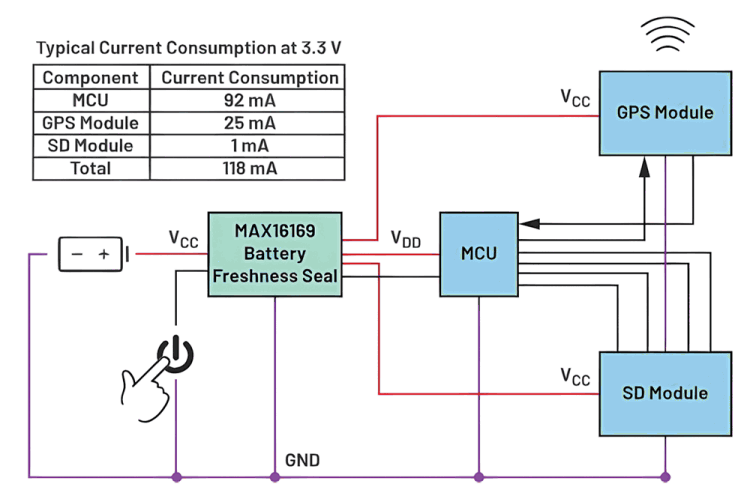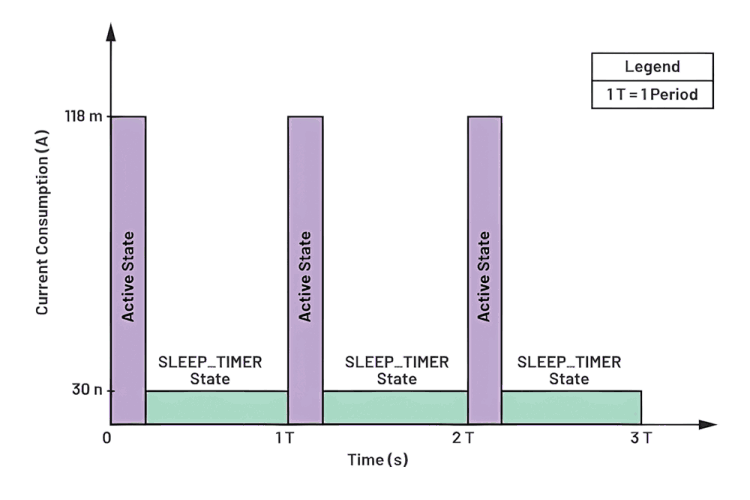
The importance of electronic system efficiency has grown more significant, alongside electronics companies’ ongoing sustainability efforts due to the United Nations’ 2030 Sustainability Agenda. This emphasises the need for solutions that promote energy efficiency, not just during field operation, but also during production.
Pushing energy efficiency efforts with on/off controllers
Efficient resource utilisation is crucial for achieving sustainability goals. This can be achieved in a variety of ways. One simple approach is to turn off electronic devices when not in use to avoid unnecessary energy consumption. Another effective method is to incorporate efficient and reliable designs through the implementation of power-saving mechanisms.
On/off controllers serve as an excellent way to reach these goals, particularly those that can function as battery freshness seals. These controllers disconnect the entire circuit from the battery when not in use, helping to extend the battery life and conserve energy. This not only prolongs the product’s shelf life, but also reduces unwanted battery discharge by minimising standby power consumption and, thus, energy wastage.
Reducing energy wastage through standby mode and sleep mode
A common issue encountered with consumer electronics is the need to charge or replace the battery before using an off-the-shelf product due to low battery levels. This shows inefficient use of energy resources and, at the same time, diminishes user experience.
To address this problem, efficient battery-powered devices incorporate low power loss circuitry or use battery freshness seals. Battery freshness seals are features of on/off controllers that prevent battery discharge by disconnecting the battery from downstream circuitry until a circuit-enabling signal, such as from a push-button, is applied. This circuit operation is commonly referred to as ship mode or standby mode, where standby mode is a more general term and ship mode is the term used specifically for the period prior to a product’s initial use.

However, with the use of battery freshness seals, battery charge drainage may still occur, affecting system efficiency. The extent of this drainage depends on the standby power consumption of the circuit. Using components with minimum power consumption may solve this problem. For instance, push-button controllers with battery freshness seals, such as the new MAX16169, having nanoampere standby current ratings, can be used, as seen in Figure 1.
Once the push-button is activated, the battery will be connected to the load. In Figure 1, the battery will be connected to the microcontroller, SD module, and GPS module. Additionally, the sleep mode feature, as found in the MAX16163/MAX16164, can be enabled to further extend battery life. It cyclically turns the system on and off for a specific time, allowing devices in the system to periodically wake up, complete tasks, and then return to sleep mode. This feature is particularly useful in wireless monitoring applications such as in the IoT where devices operate intermittently. By reducing power consumption during standby, overall efficiency is improved. Figure 2 shows how power consumption is reduced during sleep mode, indicated by the SLEEP_TIMER state, where the ACTIVE_STATE occurs when the battery is connected to the system.

Dematerialisation through integrated solutions
The best practices in PCB manufacturing involve responsible resource management. This includes dematerialisation measures to use fewer, smaller, and lighter components in a power supply. This can be done by selecting components that contain several features into one package, reducing the amount of PCB footprint required, and in turn, saving energy in manufacturing the end product. For instance, Figure 3 shows how the load switch and push-button debouncer features are combined in the MAX16150 and MAX16169, while the MAX16163/MAX16164 have an additional timing functionality.

Improving system-level robustness through high ESD-rated components
Incorporating electrostatic discharge (ESD) protection circuits in an integrated circuit is crucial for ensuring reliability in harsh environments. These circuits need to operate continuously and stably, thus, requiring adequate protection against external surges. System designers consider ESD test methods such as the human body model (HBM) for component-level ESD testing and the IEC 61000-4-2 model for system-level testing.
Component-level ESD test methods are conducted to ensure the IC can withstand the manufacturing process. The HBM simulates a scenario where a charged human body touches the IC, discharging a potentially destructive ESD through the IC to the ground. System-level ESD tests aim to ensure that the device can survive transient events during various operating conditions in real-world applications, including lightning protection.
To meet this requirement, the released product must undergo rigorous testing against the IEC 61000-4-2 ESD standard that simulates real-world transient conditions. While both the HBM and IEC 61000-4-2 ESD test methods simulate a charged person discharging into an electronic system, the IEC 61000-4-2 standard differs from the component level ESD.
Table 1 shows that the peak current in an HBM test is 5,6 times lower than the pulse current in IEC 61000-4-2 testing. In terms of the number of strikes, the component level-HBM test considers only one positive and one negative strike, whereas the system-level IEC 61000-4-2 requires a minimum of 10 positive and 10 negative strikes for an IC to pass. This means that system engineers should consider much higher HBM rated components to pass a corresponding IEC 61000-4-2 rating. For example, a system with an HBM ESD rating of +15 kV, such as the MAX16150, may meet the IEC 61000-4-2 rating of ±2 kV. Similarly, components with a +40 kV HBM ESD rating, such as the MAX16163/MAX16164 and the new MAX16169, can assist in achieving ±6 kV IEC 61000-4-2 compliance.
A higher ESD rating indicates greater robustness against harsher environments. This not only enhances a system’s reliability, by minimising operational interruption in the field, but also reduces the likelihood of failure, and thus frequent product replacements. ADI’s on/off controllers and battery freshness seals feature ESD-protection structures on all pins, safeguarding against electrostatic discharges during handling and assembly. Additionally, an extra level of protection is implemented at the switch input. The high HBM ESD ratings of these seals contribute to system designs meeting IEC 61000-4-2 compliance.
Conclusion
Key to the customers’ ongoing energy efficiency efforts is the use of components that help reduce energy waste from production in the factory up to operation in the field. With this, this article showed how ADI’s push-button on/off controller and battery freshness seal products help reduce energy waste through the standby mode and sleep mode, save production energy and PCB footprint through their integrated features, and add robustness in the field through higher ESD ratings.
| Tel: | +27 11 923 9600 |
| Email: | [email protected] |
| www: | www.altronarrow.com |
| Articles: | More information and articles about Altron Arrow |

© Technews Publishing (Pty) Ltd | All Rights Reserved